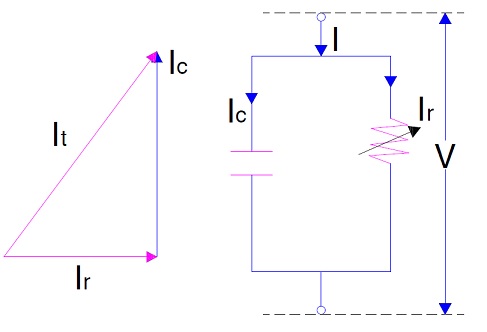3rd Harmonic Leakage Current Test is performed on Surge / Lightening Arrestor (LA) to monitor its healthiness.
Need for Monitoring of LA
The need for monitoring of Metal Oxide Lightening Arrestor (LA) arises as its deterioration may lead to heating and consequent blasting. Though LA being cheaper can be replaced but blasting of LA can create disaster. The fragments may cause mechanical damage to nearby Current Transformers, CVTs, Bushing etc. which is much costlier to replace.
There is one another reason but most important aspect which demands periodic testing of LAs. LAs protect Transformers, Switchyard Equipment from voltage surge. But a defective LA may not be able to do its job which will damage the equipment.
Cause of Deterioration of LA
Ageing is the most obvious cause which affects the V-I characteristics of Arrestor and hence leakage current. But moisture ingress may also result in higher leakage current and heating. Though moisture ingress is rare but poor quality or workmanship of gasket can lead to ingress of moisture. Manufacturer take care for proper sealing.
How to Monitor Healthiness of LA?
By measuring leakage current to the ground? But the leakage current through Lightening Arrestor is mostly capacitive in nature which does not cause heating of metal oxide pallets. The culprit is resistive component of leakage current. Increased resistive component of leakage current is an indication of change in V-I characteristics of LA. Excessive resistive component of leakage current causes overheating and subsequent failure. Therefore Resistive Component of Leakage Current is an indication for health monitoring of Lightening Arrestor. Resistive leakage current is only 10-20% of total leakage current under normal operating condition.
Figure below shows a simple yet useful model of metal oxide arrestor. Let us consider two cases.
Case1: Suppose
Ic = capacitive leakage current = 100 mA
Ir = Resistive component of leakage current = 10 mA
It = Total Leakage Current = 100.5 mA
Case2: Suppose this time resistive component of leakage current became triple
Ic = capacitive leakage current = 100 mA
Ir = Resistive component of leakage current = 30 mA
It = Total Leakage Current = 104.5 mA
Conclusion
So, percentage increase in total leakage current is only 4% when there is 200% increase in resistive component of leakage current. Thus merely keeping a watch on total leakage current is not going to indicate an aged or defective Arrestor. This calls for timely monitoring of resistive component of leakage current.
3rd Harmonic Leakage Current Monitoring
3rd harmonic leakage current monitoring is nothing but monitoring of 3rd harmonic resistive component of leakage current. It is the best indicator of healthiness of LA. It is accepted practice worldwide. Basically harmonic component in leakage current is produced due to non-linear nature of V-I characteristics of metal oxide pallets. Thus increased value of 3rd harmonic resistive component of leakage current implies degraded V-I characteristics i.e. defective LA.
But care should be taken while measuring 3rd harmonic leakage current. This current may also be produced due to 3rd harmonic supply voltage. Thus it should be ensured that a proper compensation exists for 3rd harmonic resistive leakage current due to 3rd harmonic supply voltage and temperature.
